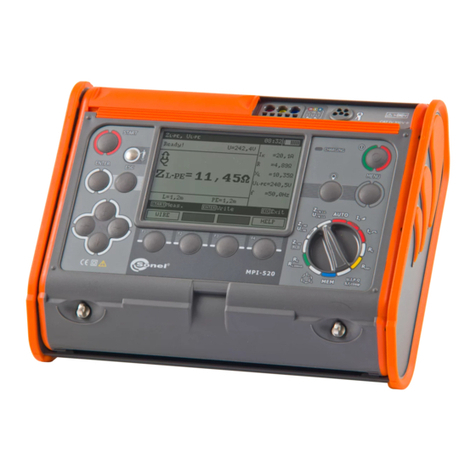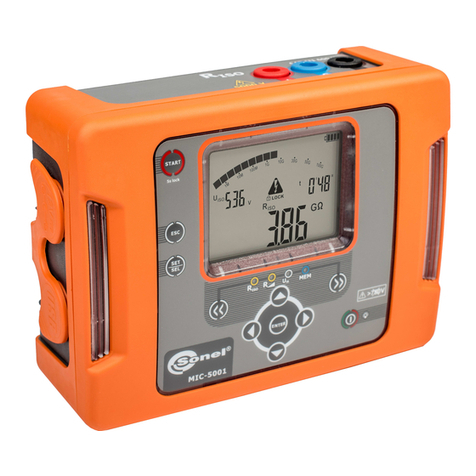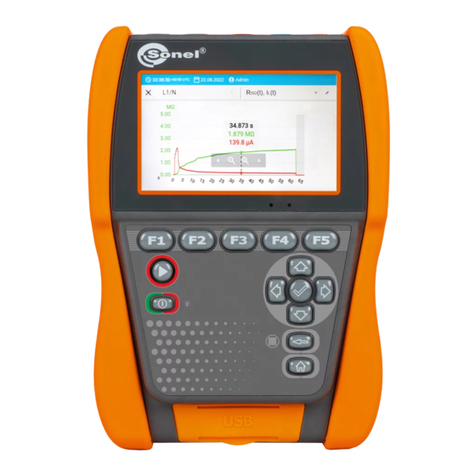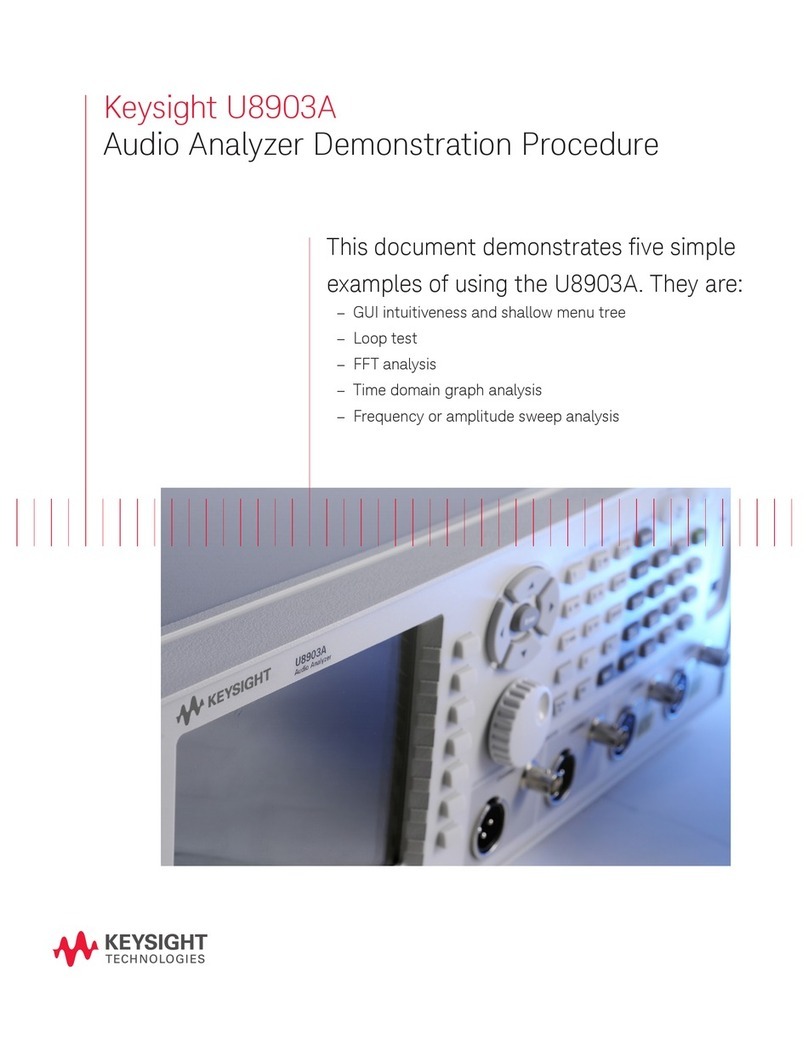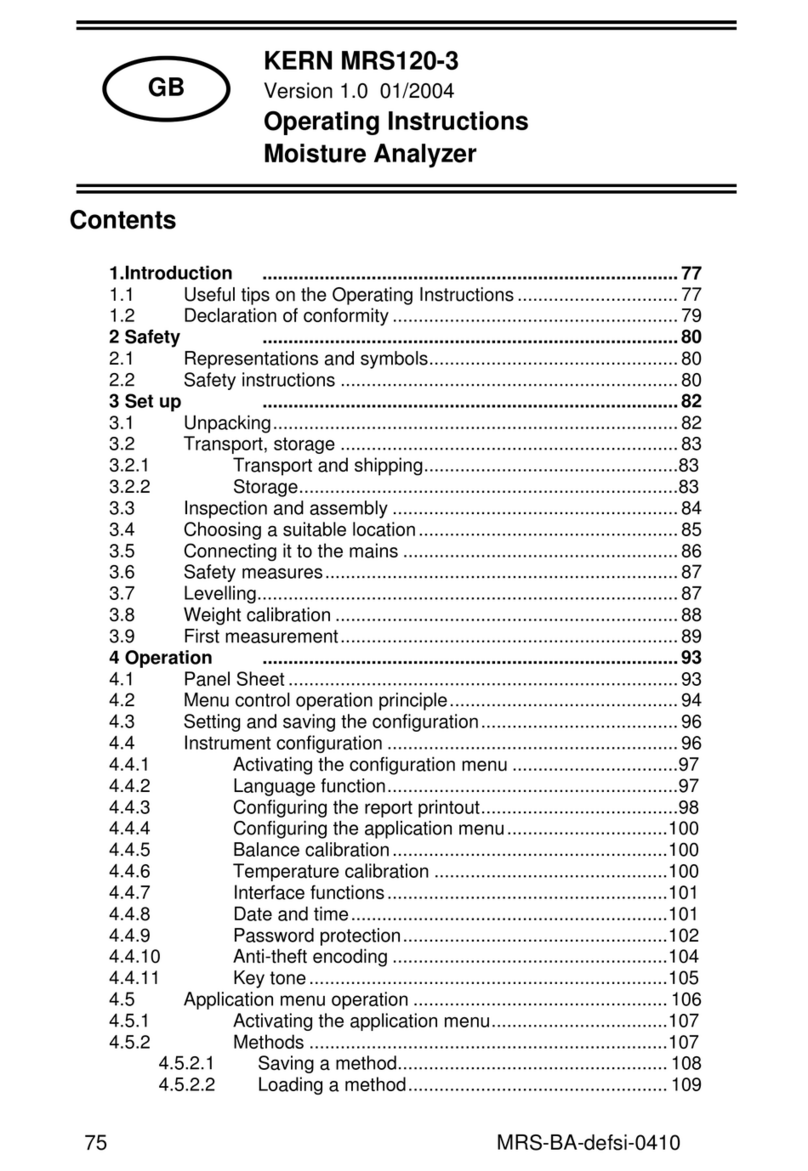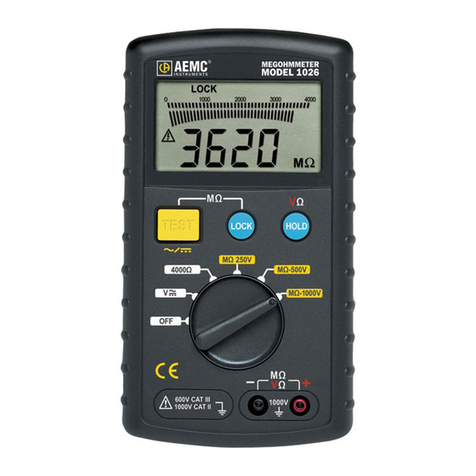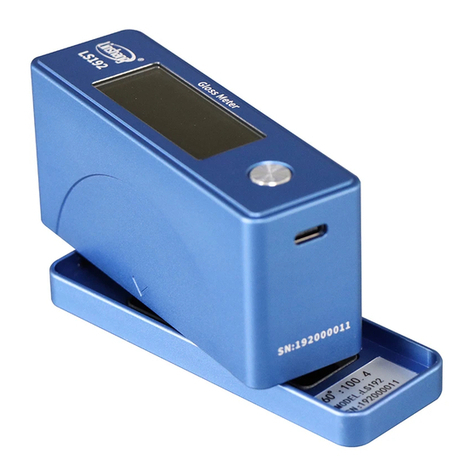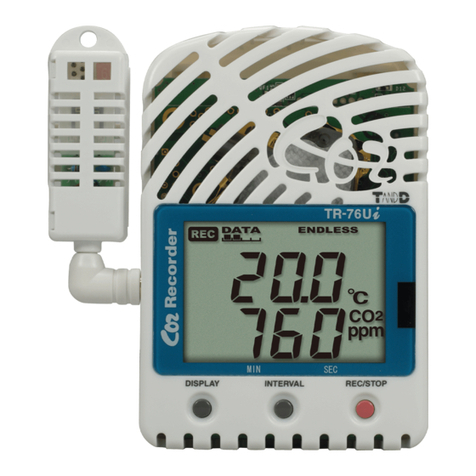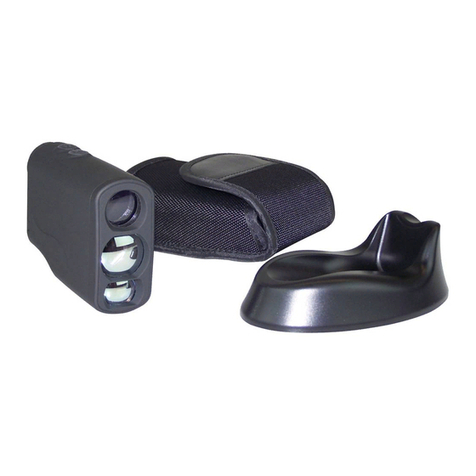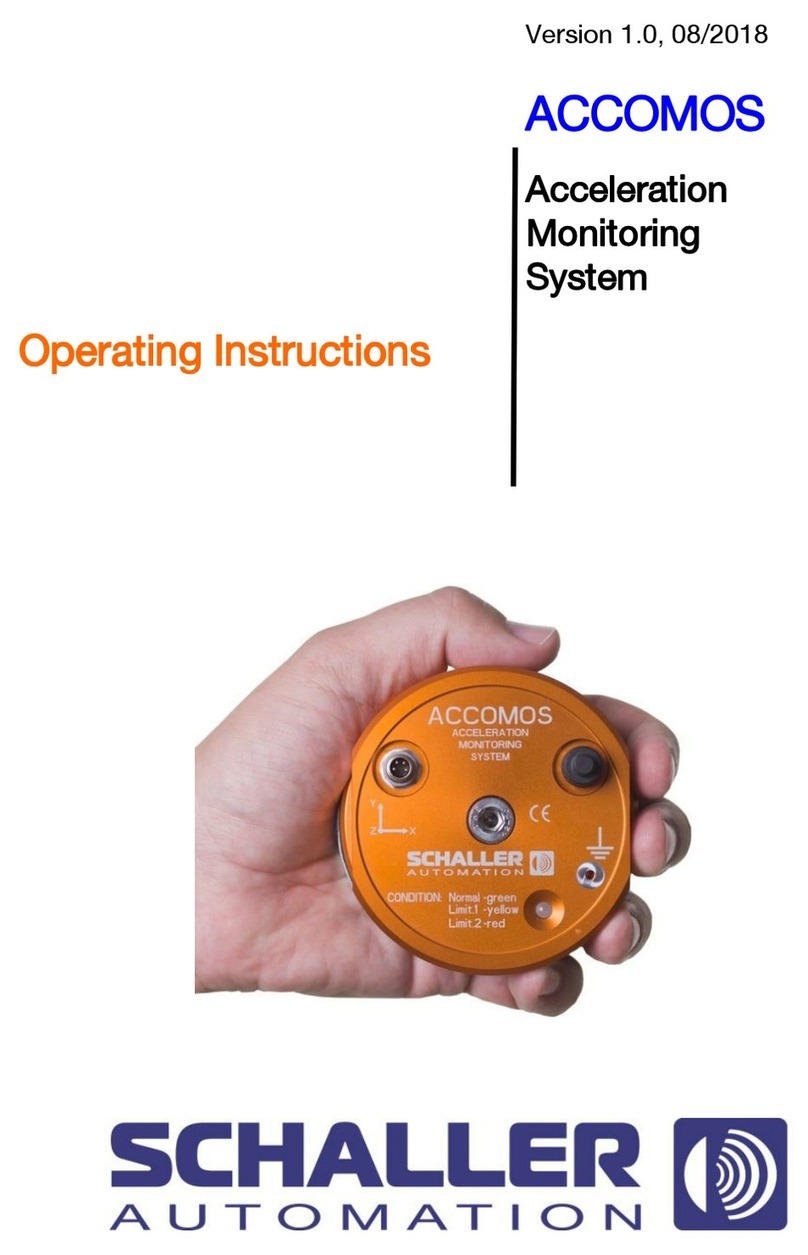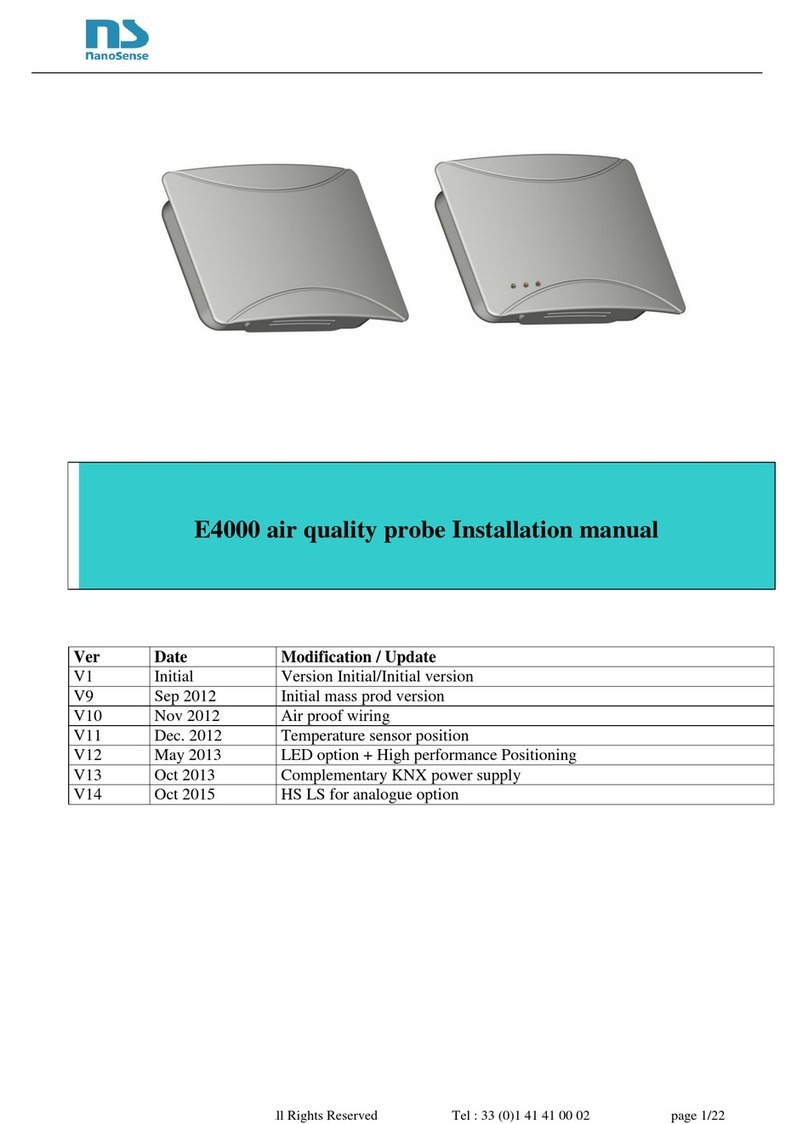Sonel MIC-15k1 User manual



USER MANUAL
INSULATION RESISTANCE METER
MIC-15k1
SONEL S.A.
Wokulskiego 11
58-100 Świdnica
Version 1.05 01.10.2019

MIC-15k1 –USER MANUAL
2
MIC-15k1 meter is a modern, top quality measuring instrument, easy and safe to use, provided that
the principles presented in this manual are observed. In addition, becoming acquainted with the man-
ual will help you avoid measuring errors and will prevent any possible problems in operation of the
meter.

MIC-15k1 –USER MANUAL
3
CONTENTS
1Safety ................................................................................................................4
2General description and features of the instrument....................................5
3Meter configuration .........................................................................................6
4Measurements................................................................................................10
4.1 Double-lead measurement..................................................................................... 11
4.2 Three-lead measurement....................................................................................... 17
4.3 Measurements with increasing voltage –SV.......................................................... 19
4.4 Measurement with ramp test –RT......................................................................... 21
4.5 Damage location ( After-burning)........................................................................ 24
4.6 Dielectric Discharge Indicator –DD ....................................................................... 26
4.7 Partial discharge indicator...................................................................................... 29
4.8 Remote control of the meter................................................................................... 29
4.9 Determining the length of the tested cable............................................................. 31
5Memory of measurement results .................................................................33
5.1 Recording measurement result data in the memory............................................... 33
5.2 Viewing memory data............................................................................................. 35
5.3 Deleting memory data............................................................................................ 37
5.3.1 Deleting bank data..........................................................................................................37
5.3.2 Deleting the entire memory .............................................................................................38
6Data transmission..........................................................................................40
6.1 Set of accessories to connect the meter to a PC ................................................... 40
6.2 Data transmission through USB port...................................................................... 40
6.3 Data transmission using Bluetooth module............................................................ 41
7Software updates...........................................................................................42
8Power supply..................................................................................................43
8.1 Monitoring the power supply voltage...................................................................... 43
8.2 Battery power......................................................................................................... 43
8.3 Charging rechargeable battery............................................................................... 43
8.4 Power supply from mains....................................................................................... 44
8.5 General rulesfor using Li-Ion rechargeable batteries................................................... 44
9Cleaning and maintenance ...........................................................................45
10 Storage............................................................................................................45
11 Dismantling and utilisation...........................................................................45
12 Technical data................................................................................................46
12.1 Basic data .............................................................................................................. 46
12.2 Additional data ....................................................................................................... 48
12.2.1 Additional uncertainties according to EN 61557-2 (RISO)..................................................48
13 Equipment ......................................................................................................49
13.1 Standard equipment............................................................................................... 49
13.2 Additional equipment.............................................................................................. 49
14 Manufacturer ..................................................................................................50
15 Laboratory services.......................................................................................51

MIC-15k1 –USER MANUAL
4
1 Safety
MIC-15k1 meter is designed for performing check tests of protection against electric shock in
mains systems. The meter is used for making measurements and providing results to determine safety
of electrical installations. Therefore, in order to provide conditions for correct operation and accuracy
of obtained results, the following recommendations must be observed:
Before you proceed to operate the meter, acquaint yourself thoroughly with the present manual
and observe the safety regulations and recommendations of the manufacturer.
Any application that differs from those specified in the manual may result in a damage to the de-
vice and constitute a source of danger for the user.
MIC-15k1 meter must be operated only by appropriately qualified personnel with relevant certifi-
cates authorising the personnel to perform works on electric systems. Unauthorized use of the me-
ter may result in its damage and may be a source of serious hazard to the user and bystanders.
During measurements of insulation resistance, dangerous voltage up to 16.5 kV
(15 kV + (0…10%)) occurs at the ends of test leads of the meter.
Before the measurement of insulation resistance you must be sure that tested object is disconnected from
the powersupply.
During the measurement of insulation resistance do not disconnect test leads from the tested ob-
ject before the measurement is completed (see chapter 4.1). Otherwise the capacitance of the ob-
ject will not be discharged, creating the risk of electric shock.
When measuring the resistance of a cable, ensure that the other end of the cable is protected
against accidental contact.
Using this manual does not exclude the need to comply with occupational health and safety regu-
lations and with other relevant fire regulations required during the performance of a particular type
of work. Before starting the work with the device in special environments, e.g. potentially fire-
risk/explosive environment, it is necessary to consult it with the person responsible for health and
safety.
It is unacceptable to operate:
a damaged meter which is completely or partially out of order,
a meter with damaged insulation,
a meter stored for an excessive period of time in disadvantageous conditions (e.g. excessive
humidity). If the meter has been transferred from a cool to a warm environment with a high level
of relative humidity, do not start measurements until the meter is warmed up to the ambient tem-
perature (approximately 30 minutes).
Remember that message appearing on the display indicates insufficient voltage of power
supply and the need to recharge the batteries.
The symbols ErrX, where Xis a number between 0 to 9, indicate incorrect operation of the meter.
If after restarting the device this situation is repeated - it indicates that the meter is damaged.
Before measurement, choose a correct measurement function and make sure that test leads are
connected to respective measuring terminals.
Do not power the meter from sources other than those listed in this manual.
The RISO inputs of the meter are protected electronically from overload (e.g. due to having been
connected to a live circuit) up to 1500 V for 60 seconds.
Repairs may be performed only by an authorised service point.
Due to continuous development of the meter’s software, the actual appearance of the
display for some features may slightly differ from that presented in this operating
manual.

MIC-15k1 –USER MANUAL
5
2 General description and features of the instrument
Digital MIC-15k1 meter is designed to measure the insulation resistance. The most important features
of the device include:
Measurement of insulation resistance
test voltages: 500 V, 1000 V, 2500 V, 5000 V, 10 000 V and 15 000 V or adjustable within
the range of 50…15 000 V
measurement of insulation resistance up to 40 TΩ
measurement with ramp test (RT) or step voltage (SV)
measurement of dielectric discharge DD
After-burning function
indicating leakage currents
direct measurement of one or two absorption coefficients
acoustic indication of five-second intervals to facilitate capturing time parameters for insula-
tion resistance measurements
capacitance measurement of the tested object
determining the length of cable
automatic discharge of the capacitance of tested object after the insulation resistance
measurement is completed
the device makes it possible to perform measurements in heavily disturbed environment
Other
automatic selection of measuring range
memory of measurement results with the option for data transfer to a PC via Bluetooth, USP
or RS-232 (optional)
large, readable display with backlight option
monitoring of the battery charge status
AUTO-OFF function
ergonomic operation
work with a mobile application that makes it possible to control the meter, read the data and
present them on an on-going basis in a graphic form
work with a dedicated software for collecting and analysing data stored in the meter's
memory.

MIC-15k1 –USER MANUAL
6
3 Meter configuration
Turn off the meter.
While holding down the MENU button, press the ON/OFF button shortly.
Keep the MENU button pressed as long as icon appears.
Buttons are used to go to the next parameter.
Buttons are used to set the parameter value.
During parameter setting, holding the buttons pressed for a longer time
accelerates changing its value.
After reaching the approximate target value, tune the value to the desired
level by pressing briefly.
The setting sequence is as follows:
Rated grid frequency (50 Hz or 60 Hz).
Auto-off time (300 s, 600 s, 900 s) or none (- - - -).

MIC-15k1 –USER MANUAL
7
PIN for the Bluetooth connection. The digit being set is
blinking. Move to the next digit with the F3 and F4 but-
tons.
The code is used to prevent access of unauthorized
persons to the meter via wireless connections (third
persons).
The same PIN code needs to be entered:
in the computer software for wireless transmission
(SonelReader),
in the mobile application Sonel MIC Mobile to es-
tablish a connection.
Absorption coefficients for RISO:
Ab1, Ab2 ( )
or
PI, DAR ( ).
Each change sets the t1, t2 and t3 to their default val-
ues.
For Ab1/Ab2 t1 = 15 s, t2 = 60 s, t3 = 0.
For PI/DAR t1 = 30 s, t2 = 60 s, t3 = 0).
Setting the limits: enabling ( ) and disabling ( ).
For status there are new parameters to be set.
In insulation resistance measurement: resistance
limit RISO (chapter 4.1 step ).
In RT function: final measurement voltage UISO,
leakage current limit IL(chapter 4.4 step ).
Software updates. This topic is discussed in chapter
7.

MIC-15k1 –USER MANUAL
8
Sounds: enabling ( ) and disabling ( ).
Test voltage accuracy:
Hi –0…5%,
Lo –0…10%.
For instance, for setting Hi and test voltage of 1000 V,
the meter will generate a voltage of approx. 1050 V.
Wireless Bluetooth communication:
- disabled,
- enabled.
When the communication is enabled, HV LED flashes
blue.
Current time.
Use buttons to move from setting hours to
minutes and the other way round.
Set the value with buttons.

MIC-15k1 –USER MANUAL
9
Current date (YY-MM-DD).
Use buttons to move from setting the year to
the month and the day.
Set the value with buttons.
or
Press ENTER to go to the measurement screen with
change approval.
Press ESC to go to the measurement screen without
change approval.

MIC-15k1 –USER MANUAL
10
4 Measurements
WARNING
During a measurement, switching of the range switch is forbidden because it may dam-
age the meter and pose a threat to the user.
The tested object must not be live.
Take particular care during cable measurement. The risk of electric shock is present also
after discharging their capacitance by the meter, as the voltage can be rebuilt automati-
cally.
The result of the last measurement is remembered until it is overwritten when the temporary
memory of the meter is full (chapter 5).
The result is displayed on the screen for 20 seconds. After that time, the meter goes to the read-
iness mode for the next measurement.
The last result may be recalled by pressing ENTER –also after the meter is turned off and
turned back on again. Other unsaved results can be recalled as described in chapter 5.
During measurement, especially of high resistances, make sure that test leads do not touch
each other and crocodile clips, because such a contact may cause the flow of surface cur-
rents resulting in additional error in measurement results.
By pressing F2, time and date can be recalled. Pressing it for the third time results in the return
to the measurement screen.
Inverter output current ISC is limited at 1.2 mA, 3 mA, 5 mA, 7 mA or 10 mA level (10 mA availa-
ble only for After-burning function). Activation of the current limit is indicated by a continuous
beep. The measurement result is correct, but on the test terminals the voltage is lower than the set
voltage. The current limitation occurs in the first phase of the measurement due to charging the ca-
pacitance of the tested object.
Graph 4.1. The actual test voltage UISO as a function of the measured insulation resistance RISO
(for maximum test voltage)

MIC-15k1 –USER MANUAL
11
4.1 Double-lead measurement
Set the rotary switch of function selection at one of
RISO positions, selecting in this manner the meas-
urement voltage.
For positions 50…15000 V, additionally, any voltage
from this range can be selected (step ) in steps of
10 V.
The meter is in the voltage measurement mode.
Press MENU to go to:
selection of test voltage Un(for switch positions
50…15000 V, an additional option of test voltage
selection is available),
selection of times for calculating absorption coef-
ficients (t1, t2, t3),
total measurement time t, meter current ISC and
the limit.
Buttons are used to set the parameter value.
Buttons are used to go to the next parameter.
During parameter setting, holding the buttons
pressed for a longer time accelerates
changing its value.
After reaching the approximate target value, tune
the value to the desired level by pressing
briefly.
The setting sequence is as follows:

MIC-15k1 –USER MANUAL
12
Test voltage Un(only for positions 50…15000 V).
Time intervals:
t1 (1 s…600 s),
t2 (1 s…600 s, but >t1),
t3 (1 s…600 s, but >t2),
t (independent of t1, t2 and t3: 1 s…99 min 59 s).
Setting the times t1…t3.
Setting the total measurement time t.
Maximum current ISC forced by the meter:
1.2 mA,
3 mA,
5 mA,
7 mA.

MIC-15k1 –USER MANUAL
13
Limit. This option is available if in chapter 3
step , limit setting was enabled.
For RISO the limit is the minimum value. The range of
limit setting corresponds to the range of function:
from 1 kΩ to 40 TΩ.
The limit value is set using the and buttons.
During parameter setting, holding the buttons
pressed for a longer time accelerates
changing its value.
After reaching the approximate target value, tune
the value to the desired level by pressing
briefly.
The limit setting is circulating. The resolution of the
set limit is related to the sub-range.
To disable the limit, set the value at - - -, i.e.:
press or in position 1 kΩ
press in position 40 kΩ.
or
Press ENTER to confirm settings (confirmed by
beep).
Press ESC to exit without saving the changes.
Connect test leads according to the drawing.

MIC-15k1 –USER MANUAL
14
The meter is ready for measurement.
Press and hold the START button for
5 seconds. This will cause 5-second countdown, af-
ter which the measurement will be started.
Testing will be continued until it reaches the preset
time (step ) or until the ESC button is pressed.
Quick start, without delay of 5 seconds, perform by
pressing ENTER and holding the START button
pressed. The measurement is stopped after reaching
the preset time or by pressing ESC.
View of the screen during measurement.
During the measurement, buttons can be
used to change the display of the currently supplied
test voltage UISO to the leakage current IL.
The device is equipped with an advanced digital fil-
ter for result stabilisation in particularly difficult and
unstable measurement conditions. When the F1 but-
ton is pressed before or during the measurement, the
meter will make calculations which will stabilise the
fluctuations of the test results. The meter displays a
filtered value of measurements for a specified time
period.
The filter is selected by pressing F1. The setting is
circulating. Subsequent pressing presents the filtered
result from the last:
10 s (F 10),
30 s (F 30),
60 s (F 60),
100 s (F 100),
200 s (F 200),
then, the filter is switched off (F - -).
Filter setting is automatically deleted after turning the
5 s

MIC-15k1 –USER MANUAL
15
meter off and on or when the rotary function switch is
changed.
The possibility of filter setting depends on the meas-
urement time set. E.g. by setting t = 20 s, we can set
the filter only for 10 s.
After the measurement is completed, read the result.
Use the F3 and F4 buttons (SCREEN) to see individ-
ual components of the result in the following order:
RISO → ILand C→ Rt1 i It1 → Rt2 and It2 → Rt3 and
It3 →
→ Ab1 (DAR) → Ab2(PI) → RISO → limit → …
where:
C –capacitance of the tested object.
Additional information displayed by the meter
Test voltage is present on terminals of themeter.
Interference voltage lower than 50 V DC or 1500 V AC is present on
the tested object. Measurement is possible but may be burdened with
additional uncertainty.
Activation of current limit. The symbol displayed is accompanied by
a continuous beep.
Breakdown of the tested object insulation, the measurement is inter-
rupted. The message appears after displaying for
20 s during the measurement, when the voltage previously reached
the nominal value.
Un>50 V
(for DC voltage)
or
Un~>1500 V
(for AC voltage)
During the measurement, a voltage appeared or the object cannot
be discharged for 120 seconds. After 5 seconds the meter returns to
its default state - voltmeter. In addition to the displayed information:
a two-tone beep occurs,
red LED flashes.
NOTE!
During measurements of insulation resistance, dangerous voltage up to 15 kV +
(0…10%) occurs at the ends of test leads of the meter.
It is forbidden to disconnect test leads before the measurement is completed. Failure
to obey the above instruction will lead to high voltage electric shock and make it im-
possible to discharge the tested object.
Take particular care during cable measurement. After discharging their capacitance
by the meter the voltage can be rebuilt automatically.

MIC-15k1 –USER MANUAL
16
Disabling t2 will also disable t3.
TimermeasuringthemeasurementtimeisstartedwhenUISO voltageisstabilized.
Icon informs of an operation with limited inverter power (Graph 4.1) If this
condition persists for 20 seconds, the measurement is stopped.
If the meter is unable to charge the capacitance of the tested object, is dis-
played and after 20 s the measurement is stopped. Then, if possible, the setting of
current ISC should be increased and the measurement repeated. Such need may
arise, e.g. in the case of testing power cables with large capacitance.
A short tone informs of the lapse of 5-s periods of time. When the timer reaches
characteristic points (tx times), then for 1 second, an icon of this point is displayed
which is accompanied by a long beep.
If the value of any of the measured partial resistance is out of range, the value of the
absorption coefficient is not shown - horizontal dashes are displayed.
During the measurement a yellow LED is lit.
After completion of measurement, the capacitance of the object tested is dis-
charged by shorting RISO+and RISO-terminals with resistance of 255 kΩ. At the same
time, the message is displayed, as well as the value of voltage UISO that is pre-
sent at that time on the object. UISO decreases over time until it is fully discharged.
In case of power cables measure the insulation resistance between each conductor
and other conductors shorted and grounded (Fig. 4.1, Fig. 4.2). In shielded cables,
the shield is also shorted.
Fig. 4.1. Measurement of an unshielded cable
Fig. 4.2. Measurement of a shielded cable

MIC-15k1 –USER MANUAL
17
4.2 Three-lead measurement
In transformers, cables, insulators, etc. there is surface resistance that can distort the meas-
urement result. To eliminate it, a three-lead measurement with G–GUARD socket is used. An exam-
ple of the application of this method is presented below.
Measurement of inter-winding resistance of a transformer.Connect Gsocket to the trans-
former tank, and RISO+and RISO-sockets to the windings.
Measurement of insulation resistance between one of the windings and the transformer
tank. Gsocket of the meter should be connected to the second winding, and RISO+socket to the
ground potential.

MIC-15k1 –USER MANUAL
18
Measurement of cable insulation resistance between one of cable conductors and its
shield. The effect of surface currents (important in adverse weather conditions) is eliminated by
connecting a piece of metal foil insulating the tested conductor with G socket of the meter.
The same shall apply when measuring the insulation resistance between two conductors of the
cable - other conductors that do not take part in the measurement are attached to Gterminal.
Insulation resistance measurement of high voltage breaker. G socket of the meter is con-
nected with the insulators of disconnector terminals.
Table of contents
Other Sonel Measuring Instrument manuals
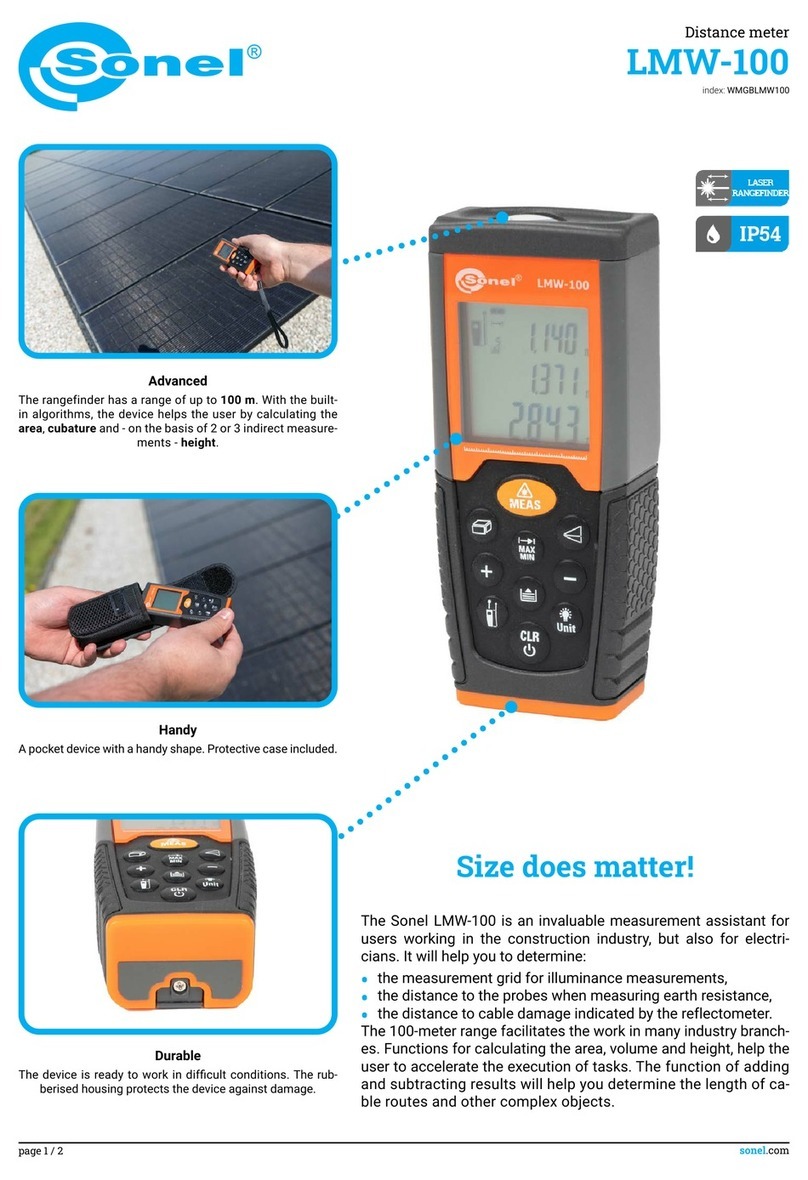
Sonel
Sonel LMW-100 User manual
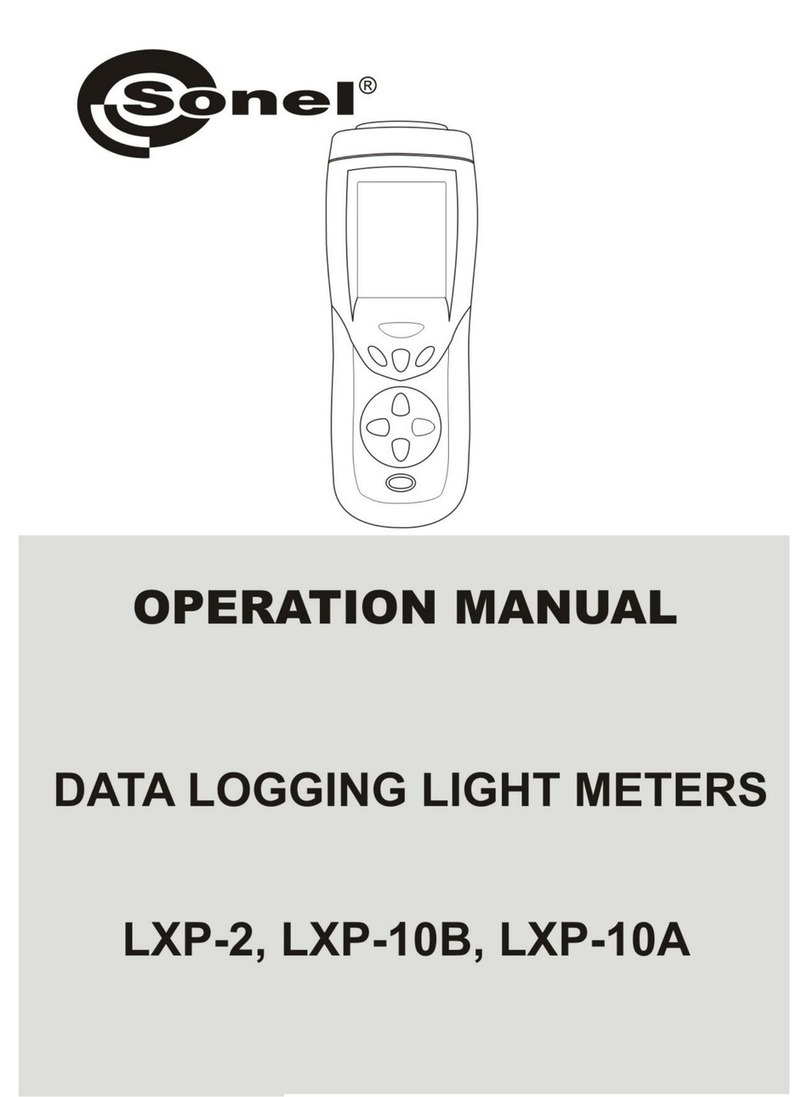
Sonel
Sonel LXP-2 User manual
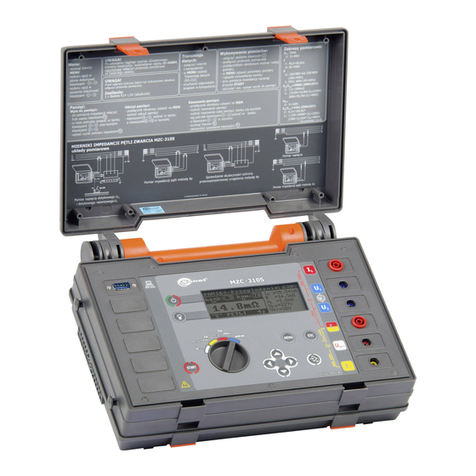
Sonel
Sonel MZC-310S User manual
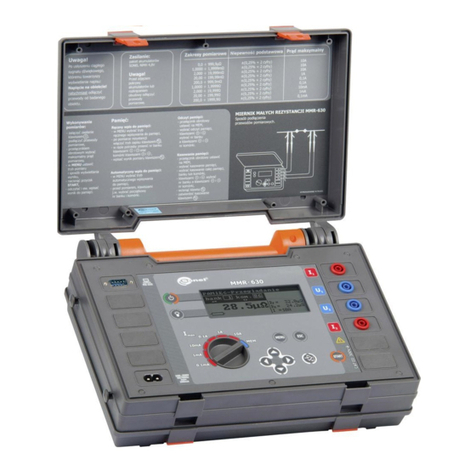
Sonel
Sonel MMR-620 User manual

Sonel
Sonel WMGBCMP3kR User manual
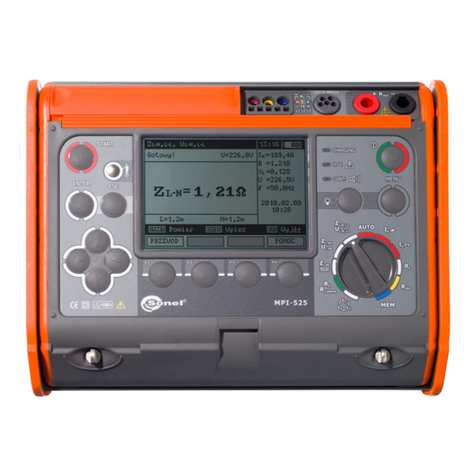
Sonel
Sonel MPI-525 User manual
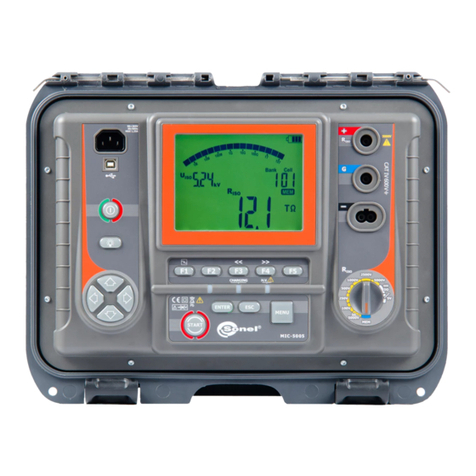
Sonel
Sonel MIC-5010 User manual
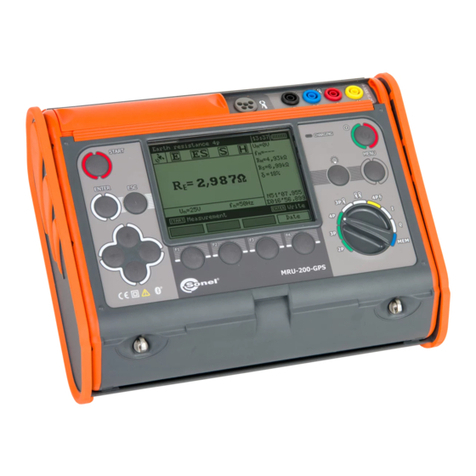
Sonel
Sonel MRU-200-GPS User manual

Sonel
Sonel MPI-525 User manual
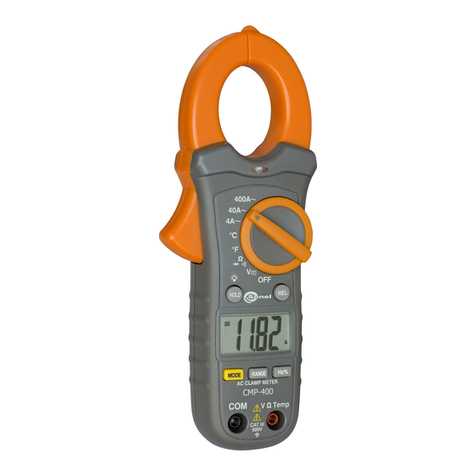
Sonel
Sonel CMP-400 User manual
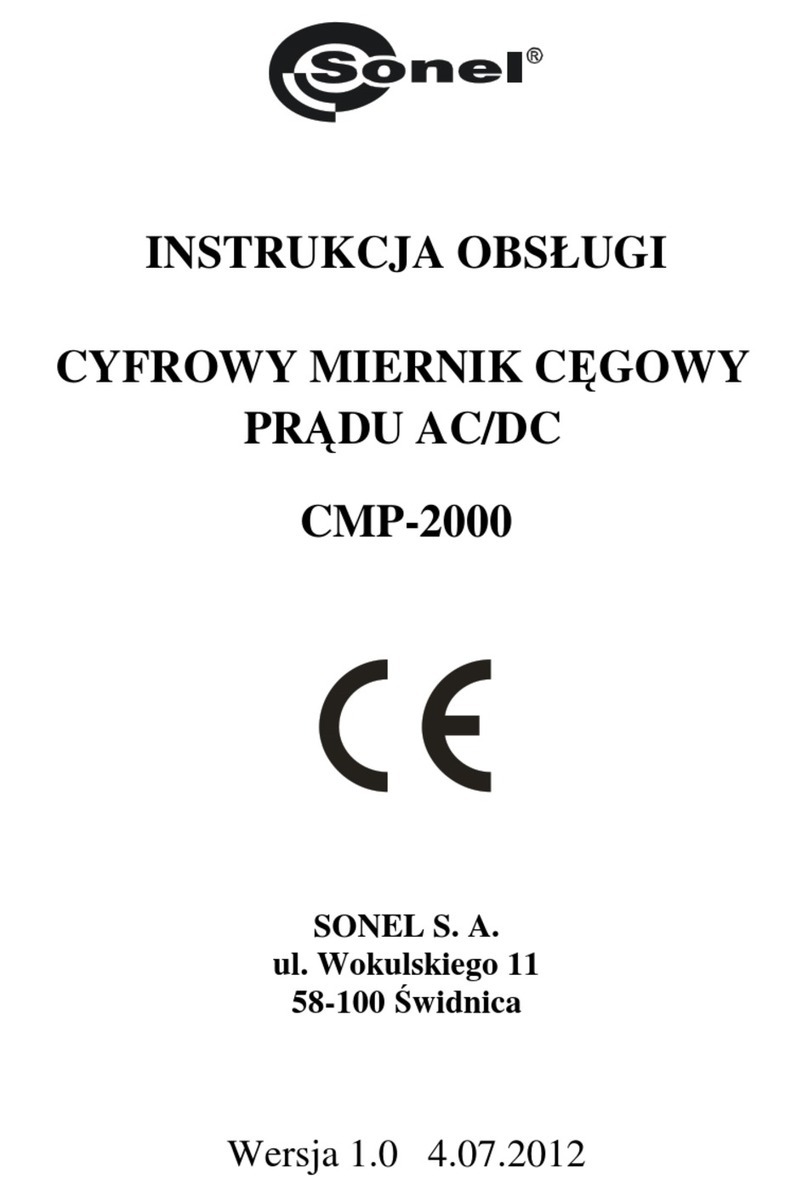
Sonel
Sonel CMP-2000 User manual
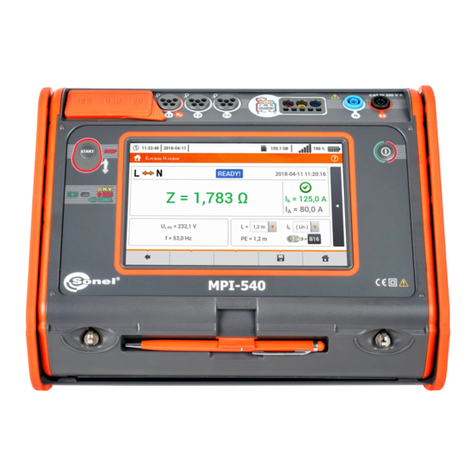
Sonel
Sonel MPI-540 User manual

Sonel
Sonel CMP-400 User manual
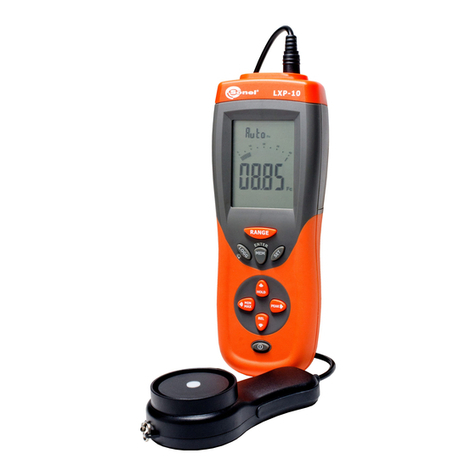
Sonel
Sonel LXP-10B User manual
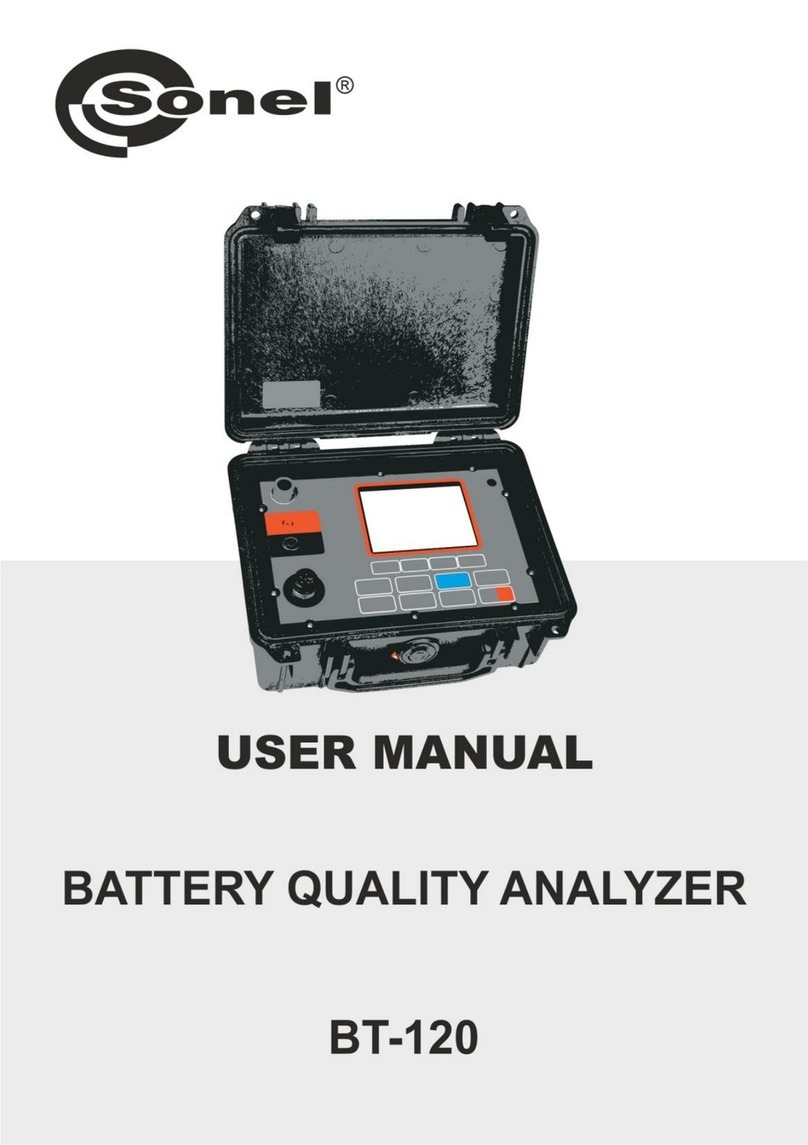
Sonel
Sonel BT-120 User manual

Sonel
Sonel MRU-120 User manual

Sonel
Sonel MIC-2501 User manual
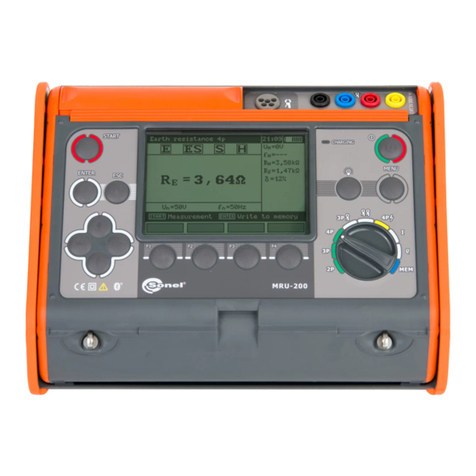
Sonel
Sonel MRU-200 User manual
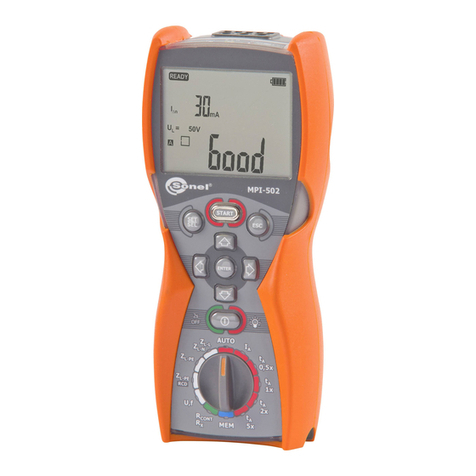
Sonel
Sonel MPI-502 User manual
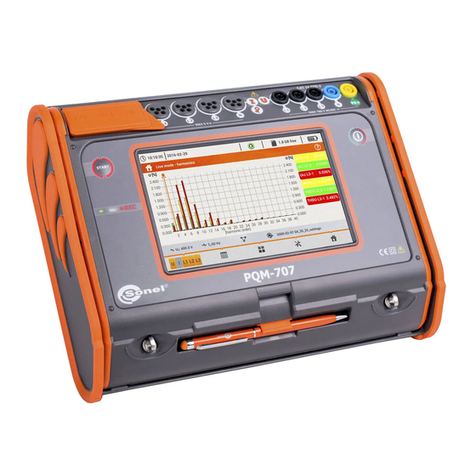
Sonel
Sonel PQM-707 User manual
